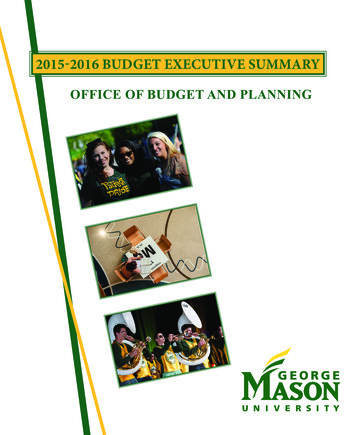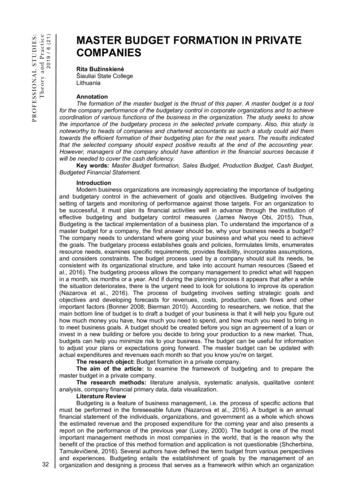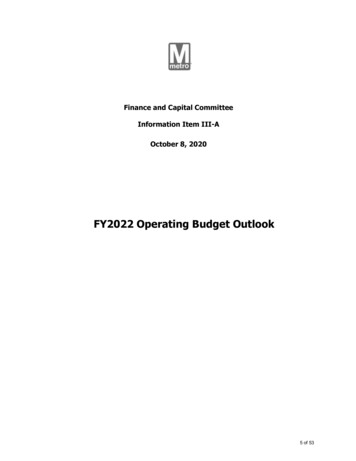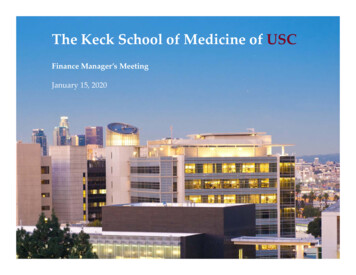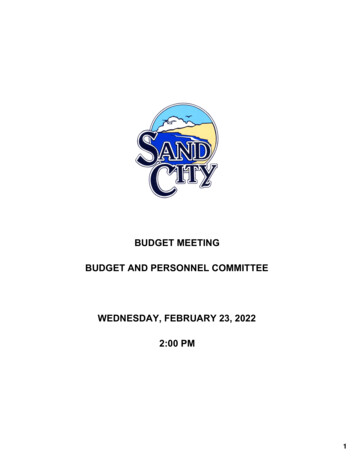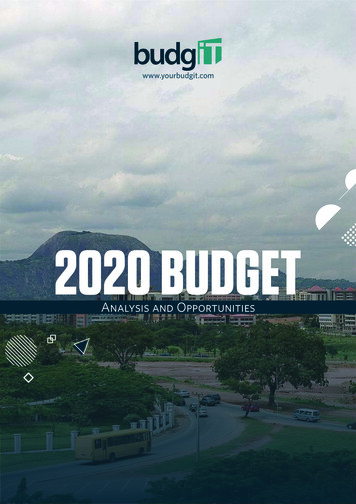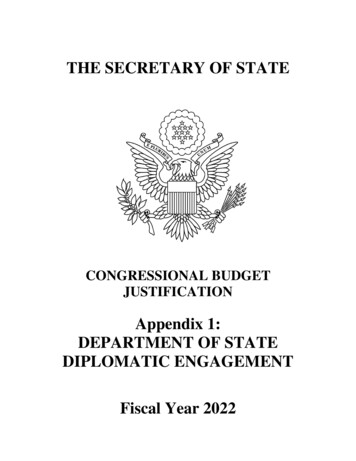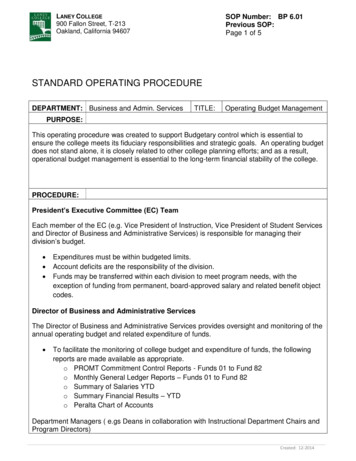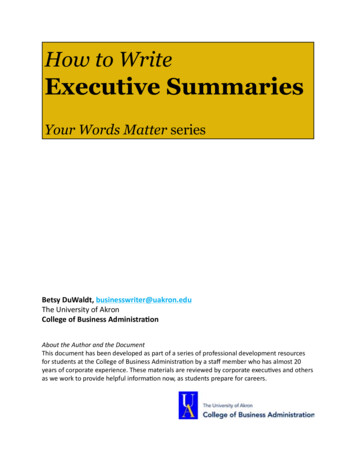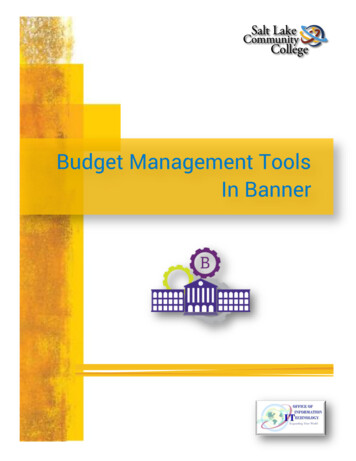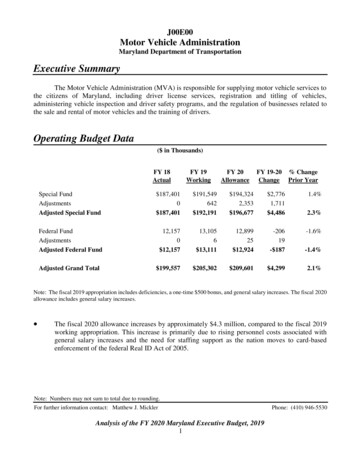
Transcription
J00E00Motor Vehicle AdministrationMaryland Department of TransportationExecutive SummaryThe Motor Vehicle Administration (MVA) is responsible for supplying motor vehicle services tothe citizens of Maryland, including driver license services, registration and titling of vehicles,administering vehicle inspection and driver safety programs, and the regulation of businesses related tothe sale and rental of motor vehicles and the training of drivers.Operating Budget Data( in Thousands)FY 18ActualFY 19WorkingFY 20AllowanceFY 19-20Change% ChangePrior YearSpecial FundAdjustmentsAdjusted Special Fund 187,4010 187,401 191,549642 192,191 194,3242,353 196,677 2,7761,711 4,4861.4%Federal FundAdjustmentsAdjusted Federal Fund12,1570 12,15713,1056 13,11112,89925 12,924-20619- 187-1.4%Adjusted Grand Total 199,557 205,302 209,601 4,2992.1%2.3%-1.6%Note: The fiscal 2019 appropriation includes deficiencies, a one-time 500 bonus, and general salary increases. The fiscal 2020allowance includes general salary increases. The fiscal 2020 allowance increases by approximately 4.3 million, compared to the fiscal 2019working appropriation. This increase is primarily due to rising personnel costs associated withgeneral salary increases and the need for staffing support as the nation moves to card-basedenforcement of the federal Real ID Act of 2005.Note: Numbers may not sum to total due to rounding.For further information contact: Matthew J. MicklerAnalysis of the FY 2020 Maryland Executive Budget, 20191Phone: (410) 946-5530
J00E00 – MDOT – Motor Vehicle AdministrationPAYGO Capital Budget Data( in Thousands)Fiscal 2018ActualLegislativeFiscal 2020WorkingSpecial 18,507 36,895 31,698Federal239678690 18,746 37,573 32,388Total Fiscal 2019Allowance 43,8620 43,862The fiscal 2019 to 2024 Consolidated Transportation Program (CTP) six-year capital programfor MVA totals 143.4 million, an increase of 18 million from the prior year’s six-yearprogram total. The CTP programs 43.9 million for MVA capital expenses in fiscal 2020. Afunding increase of approximately 25.0 million for additional phases of MVA’sCustomer Connect enterprisewide information technology modernization project (formerlyProject Core) accounts for much of the fiscal 2020 MVA capital program. The new fundingsupports development, testing, roll out, and associated tasks related to the modernization of theBusiness Licensing and Vehicle Services systems.Operating and PAYGO Personnel DataFY 18ActualRegular Operating Budget PositionsRegular PAYGO Budget PositionsTotal Regular PositionsFY 19WorkingFY 20AllowanceFY 14.000.00Turnover and Necessary Vacancies, Excluding NewPositionsPositions and Percentage Vacant as of 1/1/201964.83115.503.94%6.76%Operating Budget FTEsPAYGO Budget FTEsTotal FTEsTotal PersonnelVacancy Data: Regular PositionsAnalysis of the FY 2020 Maryland Executive Budget, 20192
J00E00 – MDOT – Motor Vehicle Administration Total MVA regular positions and contractual full-time equivalents (FTE) in the fiscal 2020allowance remain level with the fiscal 2019 working appropriation for both the operating andcapital programs. The actual vacancy rate is 6.76%, or 2.82 percentage points, over budgetedturnover. MVA plans to commit its contractual FTEs to the implementation of the federal Real ID Act,as the standard moves to card-based enforcement.Key Observations Advancing Technology, Customer Services, and the Modern MVA: MVA continues toimplement innovative solutions to enhance the customer experience, specifically with regard totechnological enhancement of MVA systems. Besides offering customers new ways to engagewith MVA, these systems help MVA process walk-in customer transactions efficiently, withcustomer wait and visit times below targeted goals. However, while MVA adds customerservices enhancements to its available suite of new technologies, questions remain as to themethods of implementation and process oversight. Impacts of the Real ID Act Card-based Enforcement: With the movement to card-basedenforcement of the federal Real ID Act, MVA is beginning to position itself to handle theexpected increase in transactions associated with the collection and processing of sourcedocuments and the issuance of new, REAL ID-compliant driver’s licenses and identificationcards. MVA expects that visit and wait times will increase in coming years, as driver’s licenseand identification card transactions processed by the agency increase.Operating Budget Recommended Actions1.Concur with Governor’s allowance.PAYGO Budget Recommended Actions1.Concur with Governor’s allowance.Analysis of the FY 2020 Maryland Executive Budget, 20193
J00E00 – MDOT – Motor Vehicle AdministrationUpdates MVA Established REAL ID Look-up Tool on the MVA Website: With the shift to card-basedenforcement of the federal Real ID Act, eligible Marylanders will need to submit sourceidentification documents and obtain a new Real ID-compliant driver’s license or identificationcard, as applicable. MVA added an application to its website to help customers determinewhether they have the appropriate documents on file.Analysis of the FY 2020 Maryland Executive Budget, 20194
J00E00Motor Vehicle AdministrationMaryland Department of TransportationBudget AnalysisProgram DescriptionThe Motor Vehicle Administration (MVA) is responsible for supplying motor vehicle servicesto the citizens of Maryland. These services include: licensing all commercial and noncommercial drivers; registering and titling vehicles; issuing tags and permits for persons with a disability; issuing photo identification cards for nondriver residents; regulating motor vehicle dealers, sales staff, vehicle rental companies, driver education schools,and driver education instructors; administering the compulsory insurance compliance program, Vehicle Emissions InspectionProgram (VEIP), and driver safety programs; and coordinating the State’s highway safety efforts.Performance Analysis: Managing for Results1.Efficient Business Practices through Technological EnhancementMVA’s mission is to provide exemplary driver and vehicle services that promote Maryland’smobility and safety while enhancing process and product security. MVA strives to implement efficientand effective business processes in pursuit of this mission.MVA continues to make significant information technology (IT) investments to improveoutdated systems and increase the number of alternative service delivery (ASD) transactions performed,as a way to reduce customer wait times and improve the customer experience. Examples of new ASDservices include (1) a REAL ID status look-up tool (this item is addressed in greater detail in theUpdates section of this analysis); (2) the ability to review whether driving privileges are suspendedprior to obtaining a copy of one’s driving record, as well as the ability to print a list of the applicablesuspensions; (3) the sale of Charm Cards; (4) provisions through which commercial driver’s licenseAnalysis of the FY 2020 Maryland Executive Budget, 20195
J00E00 – MDOT – Motor Vehicle Administrationholders can obtain driver services products; and (5) the ability to renew dealer tags through the MVAeStore. In addition, MVA modified the eStore and kiosks to alert customers by email regardingtransactions made through these sources, as a means of fraud prevention, and show the customer’scurrent address when performing a duplicate transaction, to ensure that the user enters the correctaddress in subsequent transactions.As shown in Exhibit 1, 65.9% of all transactions were completed via ASD in fiscal 2018, upfrom 59.4% of all transactions the prior year. In fiscal 2019, MVA adjusted the goal for this metric to69% of all transactions completed via ASD per year. Maryland Department of Transportation (MDOT)projections suggest that MVA will exceed this.Exhibit 1ASD Transactions as Percent of All TransactionsFiscal 2013-2020 Est.80%70%60%50%40%30%20%10%0%2013201420152016ASD as % of All Transactions201720182019 Est. 2020 Est.GoalASD: Alternative Service Delivery – defined as transactions performed online via the Motor Vehicle Administration’s(MVA) eStore, at MVA kiosks, by mail, or via the telephone call center.Source: Department of Budget and ManagementAnother indicator of the efficiency of MVA business practices is the average cost per MVAtransaction. As shown in Exhibit 2, MVA’s goal is to keep the average cost per transaction at or belowAnalysis of the FY 2020 Maryland Executive Budget, 20196
J00E00 – MDOT – Motor Vehicle Administration 16.00. The average cost per transaction increased slightly in fiscal 2018 to 16.97. MVA now tracksthis metric in such a way as to allow comparison of average operations versus administrative costs pertransaction. Between fiscal 2017 and 2018, the average operations cost per transaction fell; however,this was outpaced by an increase in the average administrative cost per transaction. MDOT suggeststhat this is due to the increase in ASD transactions, as customers pay for these services via credit card,which results in additional processing fees.Exhibit 2Average Cost Per MVA TransactionFiscal 2013-2020 Est. 20.00 18.00 16.00 14.00 12.00 10.00 8.00 6.00 4.00 2.00 0.00201320142015Cost Per Transaction2016201720182019 Est.2020 Est.Goal: 16.00 or LessMVA: Motor Vehicle AdministrationSource: Department of Budget and Management2.Exemplary Customer ServiceMVA strives to keep the average customer wait and visit time at MVA branch offices to 25 and40 minutes, respectively. Wait time is the time from when a walk-in customer (i.e., a customer whodoes not use a form of ASD to complete their transaction) receives a service ticket until the time thatthe ticket number is called, whereas visit time is the sum of the wait time plus the time that it takes toAnalysis of the FY 2020 Maryland Executive Budget, 20197
J00E00 – MDOT – Motor Vehicle Administrationcomplete a customer’s transaction. Exhibit 3 shows the performance for these measures for fiscal 2013through the 2020 estimate. Wait times decreased by 4.0 minutes in fiscal 2018 compared to fiscal 2017.Average visit time also fell in fiscal 2018, driven by the decrease in wait time.Exhibit 3Average Customer Wait and Visit TimesFiscal 2013-2020 Est.45403530252015105020132014Average Wait Time20152016Average Visit Time201720182019 Est.Wait Time Goal2020 Est.Visit Time GoalSource: Department of Budget and ManagementWhile the projections suggest decreases in fiscal 2019 and 2020, MVA anticipates increases inboth metrics for fiscal 2019. These metrics are strongly correlated to the number of walk-in transactionsmanaged by branches; MVA expects an increase in walk-in transactions in fiscal 2019 as the averagenumber of driver’s license transactions per month increases.During the 2018 interim, MVA initiated the early stages of a project to modernize thedepartment’s customer traffic management system (CTM), which captures the relevant data necessaryto track average wait and visit times for walk-in customers. MVA wishes to procure a customizable,state-of-the-art, commercially available application that provides both linear and mobile queuingoptions and supports the use of personal wireless devices and other web-enabled platforms. Althoughthis is in the early stages of the procurement process, the Department of Legislative Services (DLS)Analysis of the FY 2020 Maryland Executive Budget, 20198
J00E00 – MDOT – Motor Vehicle Administrationnotes that mobile queuing could require MVA to redefine the collection of wait and visit time data,particularly if individuals can queue remotely well in advance of their visit to an MVA branch office,or reposition themselves in the queue if they are not present when their number is called. MVA hasexpressed interest in a solution that could provide both of these capabilities. MVA should update thebudget committees on the status of the CTM procurement. Additionally, MVA should commenton the anticipated impact mobile queuing may have on reporting average customer wait and visittime data.Fiscal 2019 Actions0.5% Cost-of-living Adjustment and 500 Bonus for State EmployeesThe Governor Lawrence J. Hogan, Jr. Administration negotiated a cost-of-living adjustmentwith the major State employee unions for fiscal 2019. The terms of this agreement included (1) a 2%general salary increase, effective January 1, 2019; and (2) an additional 0.5% increase and a 500one-time bonus, effective April 1, 2019. The terms of the agreement made the additional 0.5% increaseand one-time bonus contingent on fiscal 2018 general fund revenues exceeding the December 2017estimate by 75 million. This contingency was met, and the agency’s share of the general salaryincrease is 155,401 in special funds and 1,662 in federal funds. The agency’s share of the fundsavailable for the one-time bonus is 486,467 in special funds and 4,218 in federal funds.Fiscal 2020 AllowanceOverview of Agency SpendingThe MVA fiscal 2020 operating budget totals to approximately 209.6 million. Funding iscomprised of a mix of special funds from the Transportation Trust Fund and federal funds. As shownin Exhibit 4, MVA splits operating funding between one of eight subprograms: Administration; FieldOperations; Central Operations and Safety Programs; VEIP; Motorcycle Safety; InsuranceCompliance; Information Resources; and Maryland Highway Safety Office.Analysis of the FY 2020 Maryland Executive Budget, 20199
J00E00 – MDOT – Motor Vehicle AdministrationExhibit 4Spending PlanFiscal 2020 AllowanceCentral Operations and Safety Programs15.5%VEIP8.9%Motorcycle Safety0.1%Field Operations33.6%Insurance Compliance1.7%Information Resources10.4%Administration22.4%Subprogram TitleAdministrationField OperationsCentral Operations and Safety ProgramsVEIPMotorcycle SafetyInsurance ComplianceInformation ResourcesMHSOTotalPercent of Total AllowanceMHSO7.4%SF AllowanceFF AllowanceTotal Allowance 88,16121,858,4092,773,145 012,829,579 88,16121,858,40915,602,724 196,677,074 12,923,621 209,600,69593.8%6.2%094,0420000FF: federal fundMHSO: Maryland Highway Safety OfficeSF: special fundVEIP: Vehicle Emissions Inspection ProgramSource: Governor’s Fiscal 2020 Budget Books; Department of Legislative ServicesAnalysis of the FY 2020 Maryland Executive Budget, 201910
J00E00 – MDOT – Motor Vehicle AdministrationProposed Budget ChangeAs shown in Exhibit 5, the fiscal 2020 allowance increases by approximately 4.3 million,primarily due to increased personnel expenses due to salary actions and increased assistance requiredto process transactions in advance of card-based enforcement of the federal Real ID Act.Exhibit 5Proposed BudgetMDOT – Motor Vehicle Administration( in Thousands)How Much It Grows:SpecialFundFederalFundFiscal 2018 Actual 187,401 12,157 199,557Fiscal 2019 Working Appropriation192,19113,111205,302Fiscal 2020 Allowance196,67712,924209,601Fiscal 2019-2020 Amount Change 4,486- 187 4,299Fiscal 2019-2020 Percent Change2.3%-1.4%2.1%TotalWhere It Goes:Personnel Expenses3% cost-of-living adjustment (COLA) for State employees .Employee retirement system .Additional assistance and overtime to process transactions related to REAL-ID.Annualization of fiscal 2019 2.5% COLA .Workers’ compensation premium assessment .Retiree health insurance premiums .Law enforcement officer pension system .SLEOLA bargaining agreement – Motor Vehicle Administration (MVA) expenses .Other fringe benefit adjustments .Removal of costs associated with fiscal 2019 one-time 500 bonus .MVA ContractsAdjustment to reflect actual information technology (IT) maintenance and usage expenditures .Administrative hearings costs .Additional hours for security coverage at Baltimore City branch .MVA media contract.Reduction in contractor support for the Medical Advisory Board .Efficiencies gained through new IT resources contract .Reduced unit cost for new, REAL-ID compliant license .Analysis of the FY 2020 Maryland Executive Budget, 201911 -429
J00E00 – MDOT – Motor Vehicle AdministrationWhere It Goes:Other ChangesElectrical utility savings .Reduction in federal funding for the Maryland Highway Safety Office.Other .Total-93-23216 4,299MDOT: Maryland Department of TransportationSLEOLA: State Law Enforcement Officers Labor AllianceNote: Numbers may not sum to total due to rounding.General Salary IncreasesThe fiscal 2020 allowance includes funds for a 3% general salary increase for State employees,effective July 1, 2019. These funds are budgeted in the Department of Budget and Management’sstatewide program and will be distributed to agencies during the fiscal year. MVA’s share of the generalsalary increase is 1,994,529 in special funds and 21,343 in federal funds. In addition, employees willreceive another 1% increase, effective January 1, 2020, if actual fiscal 2019 general fund revenuesexceed the December 2018 estimate by 75 million. These funds have not been budgeted. TheAdministration will need to process a deficiency appropriation if revenues are 75 million more thanprojected.Annualization of the fiscal 2019 general salary increase, as well as the 0.5% contingent increase,accounts for approximately 0.4 million in increased spending for MVA in fiscal 2020.REAL ID Implementation CostsCurrently, the provisions of the federal Real ID Act are enforced via state-based enforcement,which allows for the use of a non-REAL ID-compliant driver’s license or identification card (DL/ID)for official federal purposes (such as entering certain federal buildings or boarding commercialaircraft), so long as the issuing state has implemented certain minimum security standards for DL/IDproduction and issuance or has applied for and received an extension from the Department of HomelandSecurity (DHS) for the due date for state process compliance. Beginning October 1, 2020, the standardwill change to card-based enforcement, under which federal agencies are prohibited from accepting,for an official federal purpose, a DL/ID from any individual unless such document is aREAL ID-compliant device issued by a compliant state. Individuals without a REAL ID-compliantdevice also have the option of using an acceptable alternative device. Acceptable alternatives include,but are not limited to, a passport (both United States and foreign government issued), U.S Departmentof Defense identification (ID) (including IDs issued to dependents), a transportation workeridentification credential, or a federal Personal Identification Verification (PIV) or PIV-interoperablecard issued to federal workers (employees and contractors).Analysis of the FY 2020 Maryland Executive Budget, 201912
J00E00 – MDOT – Motor Vehicle AdministrationMaryland is compliant with the REAL ID minimum security standards for production andissuance. However, as shown in Exhibit 6, 60% of the Maryland public that are eligible for aREAL-ID-compliant device do not have the required source documentation on file with MVA as ofJanuary 2019, which will impact their ability to receive a REAL ID-compliant device. It should benoted that some of these individuals may have the new style of license; this is discussed further in theUpdates section of this analysis.Exhibit 6State of REAL ID Document Compliance for Eligible Maryland DriversJanuary 11, 20192,950,00760%1,300,00027%649,99313%Documents and DL/IDDocuments, No DL/IDNo DocumentsDL/ID: driver’s license or identification cardSource: Maryland Motor Vehicle AdministrationTotal production costs for DL/ID’s decrease by 0.4 million, as the unit cost of aREAL ID-compliant device is less than the unit cost of the devices being replaced. However, as thedate for card-based enforcement approaches, requests for DL/ID renewals and corrected devices areexpected to increase. This will require the processing and management of source documents to remaincompliant with the Real ID Act. Personnel costs increase by approximately 0.9 million for additionalassistance and overtime expenses necessary to cope with the expected uptick in transactions. Inaddition, MVA will commit the 6.50 contractual full-time equivalents budgeted to the agency to thiseffort in fiscal 2020.Analysis of the FY 2020 Maryland Executive Budget, 201913
J00E00 – MDOT – Motor Vehicle AdministrationPAYGO Capital ProgramProgram DescriptionThe Facilities and Capital Equipment Program provides funds for new capital facilities,renovations to existing facilities, the development of new major IT systems, and the purchase of capitalequipment.Fiscal 2019 to 2024 Consolidated Transportation ProgramThe fiscal 2019 to 2024 Consolidated Transportation Program (CTP) for MVA totals 143.4 million, an increase of 18 million from the prior year’s six-year program total. This is dueprimarily to increased funding for additional phases of MVA’s Customer Connect enterprisewide ITmodernization project. Exhibit 7 shows the programmed capital funds for the fiscal 2020 capitalallowance, by project and program, along with total estimated costs and six-year funding for each item.Exhibit 7Motor Vehicle Administration PAYGO Capital Allowance, by ProgramFiscal 2020( in Thousands)JurisdictionProject DescriptionProjectsStatewideAlternative Service Delivery SystemStatewideCustomer ConnectSubtotal – ProjectsFiscal2020TotalEstimatedCostSix-yearTotal 1,64825,042 26,690 33,67556,405 90,080 10,34837,805 1 48,153ProgramsStatewideSystem Preservation and Minor ProjectsStatewideCapital SalariesSubtotal – Programs 15,9001,300 17,200n/an/an/a 87,0008,300 95,300Total – Projects and Programs 43,890 90,080 143,453PAYGO: pay-as-you-go1In the fiscal 2019 to 2024 Consolidated Transportation Program, Project Core was renamed as Customer Connect in orderto differentiate it from Project Creating Opportunities for Renewal and Enterprise, within the Department of Housing andCommunity Development.Source: Maryland Department of Transportation, 2019-2024 Consolidated Transportation ProgramAnalysis of the FY 2020 Maryland Executive Budget, 201914
J00E00 – MDOT – Motor Vehicle AdministrationFiscal 2019 and 2020 Cash Flow AnalysisExhibit 8 shows the change in MVA capital spending for fiscal 2018 through the fiscal 2020allowance. Fiscal 2019 capital spending programmed in the fiscal 2019 to 2024 CTP is approximately 5.3 million less than the funding programmed in the fiscal 2018 to 2023 CTP, primarily due to adecrease in spending associated with Customer Connect (formerly Project Core); these costs weremoved forward into fiscal 2018 to support base software installation. Completion of the NetworkSwitch System Preservation project in fiscal 2018 accounts for the remainder of the overall change infiscal 2019.Programmed funding for fiscal 2020 is approximately 11.5 million more than the adjustedfunding programmed in fiscal 2019, according to the fiscal 2019 to 2024 CTP. This change isattributable to increased spending to fund additional phases of Customer Connect. The goal ofCustomer Connect is to modernize the MVA IT infrastructure, replacing legacy systems, and enhancingthe agency’s ability to provide customers and employees with a 360 degree view of their services andneeds. Improvements include the ability to conduct driver licensing, vehicle registration, and titlingtransactions at any workstation; MVA currently cannot do this, as the data systems for these servicesare independent and unconnected, requiring different terminals optimized for different tasks.Additionally, MVA seeks to develop new and further refine existing web and mobile service options.In fiscal 2020, approximately 25.0 million is programmed for the next phase of Customer Connect.Currently, funding supports early configuration costs for the Business Licensing and Vehicle Servicessystems; however, fiscal 2020 costs are associated with development, testing, roll out, and associatedtasks related to the modernization of these systems.Analysis of the FY 2020 Maryland Executive Budget, 201915
J00E00 – MDOT – Motor Vehicle AdministrationExhibit 8Cash Flow ChangesFiscal 2018-2020( in Thousands) 50 45 40 35 30 25 20 15 10 5 02018Actual2019 LegislativeSpecial Funds2019Working2020AllowanceFederal FundsMotor Vehicle Administration Capital Cash Flow ChangesFiscal 2019 Working v. LegislativeMajor ProjectsAlternative Service Delivery SystemsProject CoreSystem Preservation and Minor ProjectsWorking AppropriationLegislative AppropriationTotal Change- 3,482 0-3,482 1- 1,800 16,70018,500- 5,282Fiscal 2020 Allowance v. Fiscal 2019 WorkingMajor ProjectsAlternative Service Delivery SystemsCustomer ConnectSystem Preservation and Minor Projects 12,323 4412,279 1Total Change- 800 11,5231In the fiscal 2019-2024 Consolidated Transportation Program, Project Core was renamed as Customer Connect in orderto differentiate it from Project Creating Opportunities for Renewal and Enterprise, within the Department of Housing andCommunity Development.Source:Maryland Department of Transportation, fiscal 2019-2024 Consolidated Transportation Program,fiscal 2018-2023 Consolidated Transportation ProgramAnalysis of the FY 2020 Maryland Executive Budget, 201916
J00E00 – MDOT – Motor Vehicle AdministrationIssues1.MVA IT Error and the 2018 Primary ElectionPrior to the 2018 primary election, MVA discovered a programming error with the MVA eStoreand kiosks, which impacted certain individuals’ voter registration. On April 22, 2017, MVA modifiedsystem programming as part of an initiative to allow customers to begin an application for a driver’slicense, identification card, vehicle registration, or vehicle title at home and complete the transaction inperson. The revised programming prevented the transfer of voter registration information to the StateBoard of Elections (SBE) until the individual completed the transaction and purchased the new product.However, a programming error prevented the transfer of voter registration information when a customerupdated their voter registration or initially registered to vote following the completion of an MVAchange-of-address transaction through the website or an MVA kiosk, for which no product was issued.While MVA indicates that testing of the system programming modification was performed, itacknowledges that such testing was insufficient to identify the error.After identifying the full extent of the issue, MVA transferred 83,493 potentially impactedrecords from the period of April 22, 2017, through June 5, 2018, to SBE and worked with SBE to notifyimpacted individuals by email, where possible, and through press releases. MVA stated at a jointhearing of the Senate Education, Health, and Environmental Affairs Committee and the House Waysand Means Committee that the technical error was resolved and that, of 20,563 provisional ballots castin the primary election, 3,538 were from the impacted group. MVA continues to perform weekly auditsof the voter registration data transfer to SBE. Additionally, MVA undertook a review of its IT division,including the skill sets, capability, and turnover risk of employees and MVA’s reliance on contractors.This review found that MVA’s Office of Information Resources is maintaining and enhancing a widerange of systems, which MVA identifies as complex and outdated, and identified areas of opportunityincluding consistent adherence to policies, processes, and procedures.This comes at a time of revision and modernization of MVA IT systems generally. However,DLS notes that it took over 13 months to identify this programming error, which may not have occurredbut for the inquiry of an SBE employee as to the employee’s own voter registration status following anMVA transaction. The error was the result of an admitted failure to properly test changes made to ITsystems under MVA’s control, and MVA’s response to questions about the IT system review lacksspecificity as to the changes implemented to avoid similar failures. MVA should comment on thespecific findings of its IT systems review, including examples discovered during the review ofinconsistent adherence to industry standard policies, processes, and procedures. MVA shouldalso describe, in detail, the corrective action plan implemented as a result of the review.Analysis of the FY 2020 Maryland Executive Budget, 201917
J00E00 – MDOT – Motor Vehicle AdministrationOperating Budget Recommended Actions1.Concur with Go
For further information contact: Matthew J. Mickler Phone: (410) 946-5530 Analysis of the FY 2020 Maryland Executive Budget, 2019 1 Executive Summary The Motor Vehicle Administration (MVA) is responsible for supplying motor vehicle services to . Operating Budget Data ( in Thousands) FY 18 FY 19 FY 20 FY 19-20 % Change
